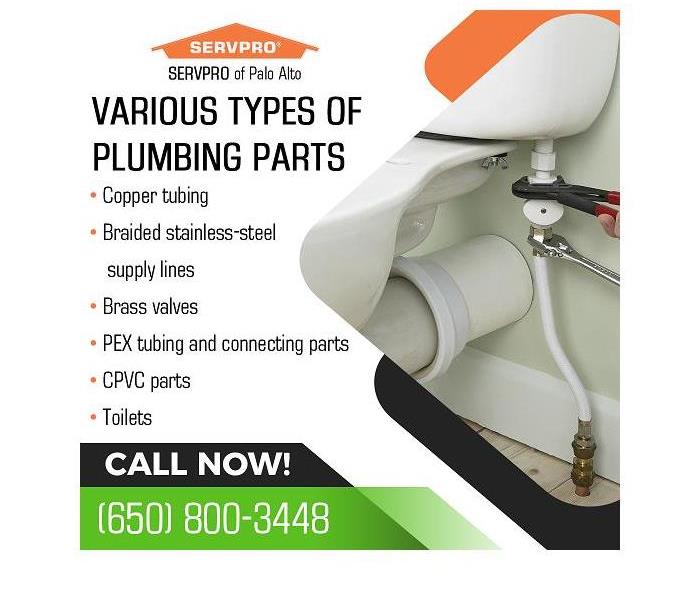How a House’s Plumbing Can Provide Clues About Leaks and Water Damage
12/14/2021 (Permalink)
Blog Summary: SERVPRO of Palo Alto explains how to identify signs of leakage that can be present on plumbing components.
SERVPRO of Palo Alto understands how disruptive and life-changing a water damage disaster caused by a plumbing problem in the home can be. Homeowners need to be aware of some common signs of water leaks in the plumbing system. A toilet supply line leaking one drop of water every 7 seconds adds up to about one gallon of water per week. If the supply line ruptures, the small leak can become a 200 gallon per hour flood. Imagine the surprise awaiting the family arriving home from a weeklong vacation to find their home flooded with thousands of gallons of water. An awareness of the common causes of plumbing leaks is the first step to avoiding water intrusion.
The primary cause of a plumbing leak stems from inadequate maintenance. Proper, timely upkeep will keep plumbing at peak performance. However, the homeowner needs to be aware of other causes of plumbing problems, including:
- Product design flaws
- Manufacturing defects
- Improper installation
- Exposure to harsh cleaning products
Regular inspections of exposed plumbing can detect a leak when it is small and no damage has occurred. If homeowners know the lifespan of a part or appliance, they can preemptively maintain or replace the item in order to prevent a water damage disaster.
Know the Signs of a Water Leak
Prevention of a plumbing leak starts with intentional inspections. Look for dripping water under the sink, around connections, or on the floor near plumbing. Feel exposed plumbing for slight leaks. Look for water damage in these areas:
- Access panels to appliances, tubs, and showers
- Under sinks and wash tubs
- Connections and valves associated with the water heater, toilets, and appliances
- Crawl spaces and basements
In general, cracking, corrosion, discoloration, and mineral deposits signal a problem. Below are specific examples to help the homeowner identify issues with various types of plumbing.
Copper tubing
Discoloration and the buildup of deposits are key indicators of a leak in copper plumbing. Discoloration and slight corrosion may not need to be addressed. Deposit buildup is a strong indication of an issue and needs immediate attention. Copper piping can develop pinhole corrosion, and small, localized crystals on the pipe signal a potential problem. A professional can take steps to mitigate the corrosion before more serious issues arise.
Streaks of white, blue, or green deposits on the copper pipe indicate a tiny amount of water is already seeping from a pinhole leak in the pipe. The corrosion may be a sign of a water chemistry problem that must be resolved, or it will continue to degrade the copper pipes. A water damage disaster can be avoided by taking the proper steps to remedy the hard water issues.
Braided stainless-steel supply lines
High-quality braided stainless-steel supply lines are the best way to connect appliances, toilets, and faucets to the main plumbing system. Stress corrosion cracking, a condition unique to braided steel supply lines, can develop. Rust, discoloration, and broken or frayed strands of steel hint at a problem. Quick action to replace the supply lines can prevent a massive flood. A ruptured washing machine supply line can spew five to seven gallons of water per minute.
Brass valves
Like copper tubing, brass valves are subject to the effects of corrosion. Deposits of a white, blue, or green crystal-like substance on or around the valve signal trouble. Exposure to harsh cleaning chemicals, water chemistry, design flaws, low-quality manufacturing, and improper installation factors into the failure of a brass valve.
PEX tubing and connecting parts
PEX parts are compromised by exposure to chlorinated hot water and household cleaning chemicals. Cracking and discoloration indicate potential problems. The metal fittings used to connect PEX can corrode. Regular visual inspections can identify these issues in their infancy before a water leak arises.
CPVC parts
CPVC pipes and connections are often used in home fire sprinkler systems. Exposure to chemicals and heat can compromise CPVC parts. Telltale signs of a potential problem include discoloration and cracking.
Toilets
A toilet has many potential leak points. A hairline crack in the brittle ceramic tank can enlarge over time, resulting in rotted flooring, a wobbly toilet, and a mold infestation. Visually inspect the outside of the tank for stains and discoloration. The flushing mechanism can malfunction, allowing large amounts of water to flood into a septic tank or the public sewer system. Frequently inspect the floor around the toilet for tank and supply line leaks. Replace the flapper valve at the first sign of an issue.
Plumbing Leak Prevention and Protection Strategies
- Incorporate an inspection of the plumbing into the cleaning routine. Check supply lines and flooring around toilets, tubs, and showers. Look for moisture under cabinets and do a smell test for mold and mildew.
- Immediately repair any plumbing issues that arise. Replace supply lines, connections, and valves before they become a water damage disaster.
- Install water sensors or an entire leak detection system. The system can be managed from a smartphone.
- Know what non-weather-related water damage the existing homeowners policy covers.
- Pre-qualify a reputable water damage restoration company with competencies and certifications in water damage restoration and mold remediation. The company should be able to handle the insurance claim process from beginning to end.
In case of a property damage disaster in a residential or commercial setting, SERVPRO of Palo Alto is available 24-hours a day, 365 days a year, to help regain control of the situation quickly and begin the restoration process.
For more details about Redwood City, CA, water damage restoration, email SERVPRO of Palo Alto at office@SERVPROpaloalto.com. The office can also be contacted by phone at (650) 800-3448.



 24/7 Emergency Service
24/7 Emergency Service
